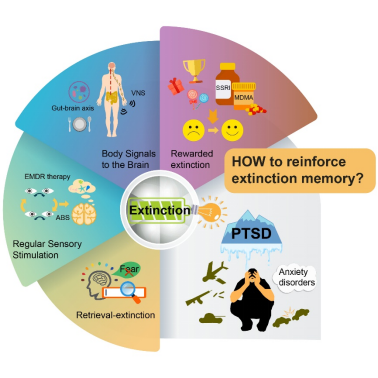
This review, titled "Memory Trace for Fear Extinction: Fragile yet Reinforceable," summarizes the neural mechanisms of fear extinction and reveals that fear extinction involves not only the dynamic modification of existing fear memory traces but also the formation of new extinction memory traces. Behavior modification in fear extinction is achieved through competitive interactions between extinction memories and fear memories, mechanically, relying on the mutual inhibition among neural ensembles corresponding to memory traces. Forgetting of fear extinction memories involves the dynamic attenuation of synaptic connections within extinction memory traces, resulting in the reactivation of partial neurons from initial fear memory trace, and experience-driven oscillations between brain regions after extinction are instrumental in the selective expression of fear or extinction memories. Therefore, advancing the development of fear extinction strategies is essential for enhancing the treatment of anxiety and post-traumatic stress disorder. Current approaches to promote extinction include memory erasure by memory updating combined with extinction training, as well as interventions that facilitate the encoding and expression of extinction memories through sensory stimuli, physiological regulation, and reward stimuli, among others. This review article was published in the "Neuroscience Bulletin" in July 2024.